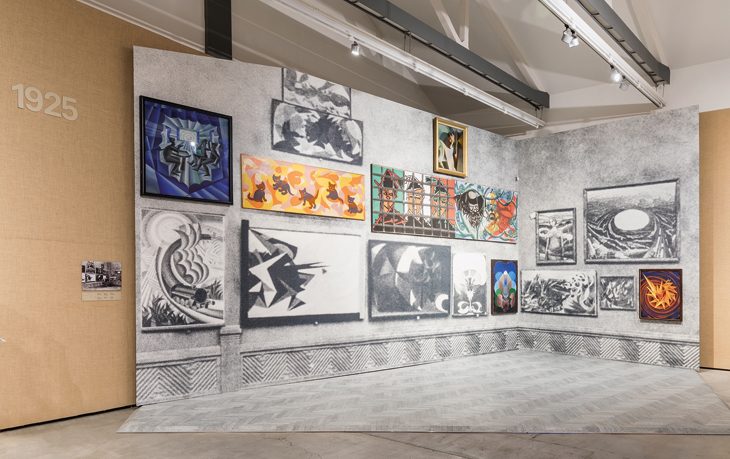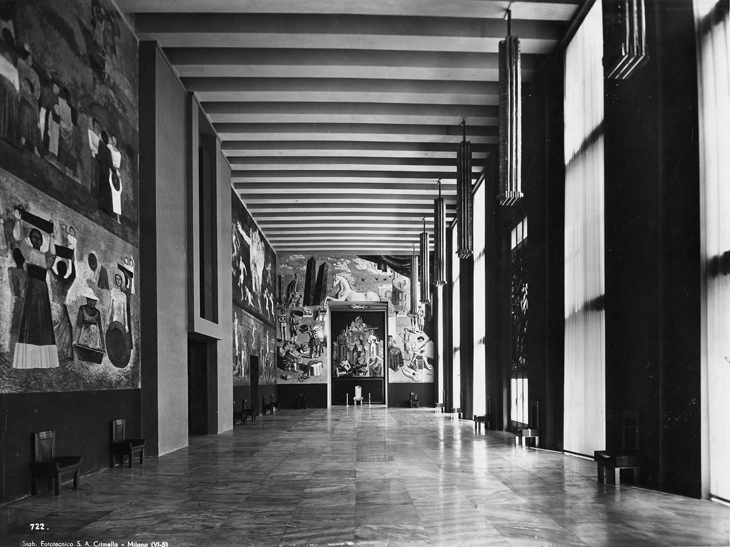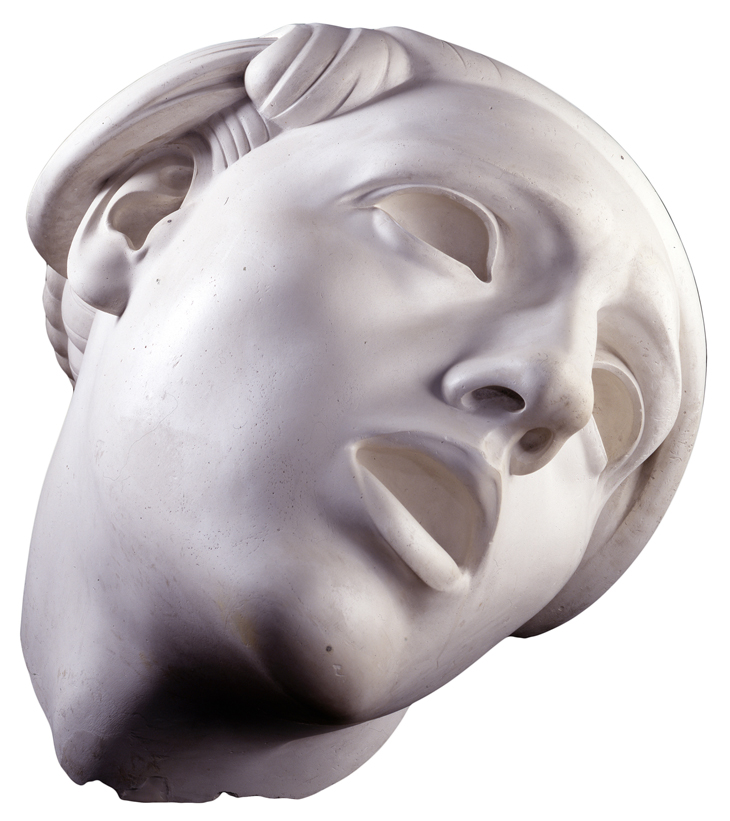From the April 2018 issue of Apollo. Preview and subscribe here.
What is the role of artists under a political regime? An extraordinary exhibition of Italian art between 1918 and 1943 – that is, under Fascism – at the Fondazione Prada asks a timely question. The polyphonic response fills the Prada’s sprawling space in Milan with over 600 artworks, plus documents, by more than 100 artists across the political spectrum, ranging from fascist advocate Mario Sironi to fierce detractor Renato Guttuso. These are organised into a chronological series of reconstructed spaces, from the domestic interior of the home of Futurist leader F.T. Marinetti to the enormous site of the Rome Universal Exposition planned for 1942, with its towering ‘square colosseum’. The exhibition’s title borrows from Marinetti’s onomatopoeically titled Zang Tumb Tuuum (1914), his concrete poem about the Battle of Adrianople and hymn to the belligerence that would soon arrive on Italian shores.
The formal variety of the work produced under Fascism and presented in this exhibition may surprise. At its outset the regime was more concerned with how art was displayed than with its style or subject, or the beliefs of its creator. In Italy the political-aesthetic relationship did not follow the poles established by the comparison of the ‘Great German Art Exhibition’ with ‘Degenerate Art’. The call-to-order classicism of Felice Casorati’s portraits jars with the expectations we may have of an anti-fascist artist; likewise Lucio Fontana’s sometime allegiance with the regime may not be readily apparent in his early abstract sculptures of 1934 (here represented by the artist’s own later reconstructions). Despite a peppering of other internationally recognised artists – Boccioni, De Chirico, Morandi – and intellectuals – Gramsci, Levi, Pirandello (their presence summoned by letters, artworks and photographs) – this is anything but a ‘masterpieces of the Fascist period’ show.

Installation view of ‘Post Zang Tumb Tuum. Art Life Politics: Italia 1918–1943’ at the Fondazione Prada, Milan, 2018. Photo: Delfino Sisto Legnani and Marco Cappalletti; courtesy Fondazione Prada
‘Post Zang Tumb Tuuum’ instead follows curatorial choices made under the Fascist regime by restaging sections of the exhibitions, biennials and quadrennials that defined its aestheticisation of politics. This focus on the structures of display in the period is well-established in academia, and many of the relevant scholars have written essays for the substantial catalogue. In the exhibition itself much-studied installation photographs have been blown up to life size and hung, where possible, with the original works. The visitor is invited to step into these grainy black and white images and to re-enact the experience of viewing these works.

Installation view, Salone delle Cerimonie, V Triennale di Milano, 1933. Works by Sironi, Severini, De Chirico, Campigli and Funi. Photo: Crimella; © La Triennale di Milano
This piece of exhibition theatre mimics the diverse aesthetics of Fascist display with unsettling slickness. Installations from Venice Biennales and Rome Quadriennales are evoked in simple hangs, sometimes against a backdrop of photographs, sometimes on hessian-covered walls. The infamous ‘Mostra della rivoluzione fascista’ (Exhibition of the Fascist Revolution) of 1932, which celebrated the regime and marked 10 years since the March on Rome, was a feverish, propagandistic torrent of art, objects and documentation. This is evoked in Prada’s enormous warehouse space by eight towering screens displaying photographs of that exhibition, which was visited by nearly four million people.
The deluge of material in ‘Post Zang Tumb Tuuum’ means that some works that deserve close attention are skied, most notably Antonio Sant’Elia’s Futurist architectural drawings, so influential on the rationalist architects of the next generation, whose works are displayed at more accessible heights. At times the discomfort of viewing becomes too much. For example, to look in the vitrine containing Margherita Sarfatti’s book Dux (1934) with its cover illustration of Adolfo Wildt’s 1924 relief of Mussolini’s face, it is necessary to bow one’s head in front of the enormous marble sculpture itself, which hangs above. Unsurprisingly, the scale of works produced by those opposed to the regime, such as Aligi Sassu’s prison drawings, is dwarfed by public commissions such as Sironi’s cartoons for mosaics in Milan’s courthouse.
The physical stamina required to view all the works on display is exceeded only by the effort needed to read the documents and letters, and the two enormous panels presenting a chronology of key political events in Italy and beyond. These provide much-needed context, as the realities of life under Fascism are all but absent from the majority of artworks. Architectural designs, like the print ephemera and archival imagery included here, present a utopian but depopulated vision. Only at the end of the show do we see Giuseppe Terragni’s portraits of soldiers at the Russian front, Corrado Cagli’s drawings of bodies piled up at Buchenwald, and a boy staring out dismally from photographs of the demolition works in Rome that made way for the imposing open-air archaeological exhibition today known as Via dei Fori Imperiali.

(1930), Adolfo Wildt. Galleria Internazionale d’Arte Moderna di Ca’ Pesaro, Venezia. Photo: Franzini C; © Archivio Fotografico – Fondazione Musei Civici di Venezia
It is apposite that an exhibition about the politics of display should take place at the Fondazione Prada, a leader among Italy’s new breed of privately funded art institutions. This exploration of art under Fascism could not have taken place in an Italian state museum, whose reliance on public funds would preclude the display of art created to glorify the Fascist regime, especially shown with such a light interpretative touch. In seeking to consider the role of artists under political regimes, ‘Post Zang Tumb Tuuum’ also highlights the role of institutions, curators, and intellectuals in creating opportunities, cultures and narratives of display.
This is a bold example among the ongoing trend for restaging historical exhibitions, provoking a quite different set of issues from the Fondazione Prada’s last reconstruction. In 2013 in Venice, Germano Celant restaged the 1969 Kunsthalle Bern show ‘When Attitudes Become Form’. The decision by Celant, ably assisted in this mammoth task by five young curators, to recreate these earlier historic exhibitions implies neutrality: the curators working in the Fascist period selected these artworks, and audiences of today can judge for themselves. But, as suggested by the sub-title ‘Art Life Politics’ and Miuccia Prada’s polemical foreword to the catalogue, the politics and aesthetics of the present – especially as this exhibition opened a fortnight before the Italian General Election – cannot be left at the gate of the Fondazione’s estate.
‘Post Zang Tumb Tuuum. Art Life Politics: Italia: 1918–1943’ is at the Fondazione Prada, Milan, until 25 June.
From the April 2018 issue of Apollo. Preview and subscribe here.














![Masterpiece [Re]discovery 2022. Photo: Ben Fisher Photography, courtesy of Masterpiece London](http://zephr.apollo-magazine.com/wp-content/uploads/2022/07/MPL2022_4263.jpg)
‘Like landscape, his objects seem to breathe’: Gordon Baldwin (1932–2025)